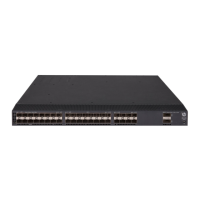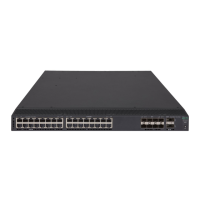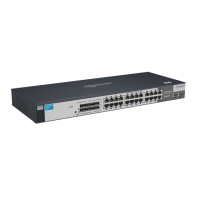27
list of the VFC interface. An FCoE frame transmitted from a VFC interface can use the VLAN ID in
VLAN_Header to identify the VLAN to which it belongs.
Creating a VSAN
By default, only the default VSAN (VSAN 1) exists. You cannot create or delete VSAN 1. You can create
VSANs 2 to 3839.
The maximum number of VSANs (including VSAN 1) allowed on a switch is 16.
To create a VSAN:
Ste
Command
Remarks
1. Enter system view.
system-view N/A
2. Create a VSAN and enter VSAN view.
vsan vsan-id By default, only VSAN 1 exists.
Configuring a trunk VSAN
VFC interfaces can be assigned to multiple VSANs as trunk ports.
If you assign an interface to VSANs as a trunk port multiple times, the new configuration does not
overwrite the old configurations. The final trunk VSAN list is the union of all the VSANs to which you have
assigned the interface.
To assign an interface to the specified VSANs as trunk ports:
Ste
Command
Remarks
1. Enter system view.
system-view N/A
2. Enter VFC interface view.
interface vfc interface-number N/A
3. Assign the interface to the
specified VSANs as a trunk
port so that the interface
allows the specified VSANs
to pass through.
port trunk vsan vsan-id-list
By default, an interface does not
belong to any VSANs (including
VSAN 1) as a trunk port.
You can assign an interface to a
nonexistent VSAN as a trunk port.
Displaying and maintaining VSANs
Execute display commands in any view.
Task Command
Display the member ports of VSANs. display vsan [ vsan-id ] port-member

